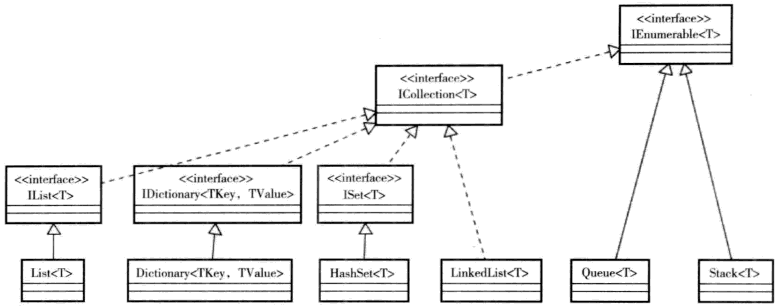c# Queue、Queue<T>、Stack、Stack<T>、Dictionary<TKey,TValue>、LinkedList<T>
//顺序存储结构,即线性表,线性表可以动态扩大或者缩小,它在一片连续区域中存储数据,线性表不能按照索引进行查找
//它是通过对地址的引用来搜索元素,为了找到某个元素,它必须遍历所有元素直到找到元素,所以线性表的优点是插入和删除数据效率高,缺点是查找效率相对低一些
//线性表分为:队列、栈、索引群集
//多线程集合类(线程安全)
//1、ConcurrentBag<T>对应List<T>
//2、ConcurrentQueue<T>对应Queue<T>
//3、ConcurrentStack<T>对应Stack<T>
//4、ConcurrentDictionary<TKey,TValue>对应Dictionary<TKey,TValue>
//队列:先进先出(FIFO:First In, First Out),应用实例:消息队列,结果:HelloWorld!
var q = new System.Collections.Queue();
q.Enqueue("Hello");
q.Enqueue("World");
q.Enqueue("!");
var qt = new System.Collections.Generic.Queue<string>();
qt.Enqueue("Hello");
qt.Enqueue("World");
qt.Enqueue("!");
//栈:后进先出(LIFO:Last In, First Out),结果:!WorldHello
var s = new System.Collections.Stack();
s.Push("Hello");
s.Push("World");
s.Push("!");
var st = new System.Collections.Generic.Stack<string>();
st.Push("Hello");
st.Push("World");
st.Push("!");
//字典:值存储在基于Key的HashCode上,如果需要进行Key查找Value,字典会使查找更快捷
var d = new Dictionary<string, string>();
d.Add("txt", "notepad.exe");
d.Add("bmp", "paint.exe");
d.Add("dib", "paint.exe");
d.Add("rtf", "wordpad.exe");
//双向链表:双向链表的每一个节点都向前指向Previous节点,向后指向Next节点
string[] w = { "the", "fox", "jumps", "over", "the", "dog" };
var l = new LinkedList<string>(w);
l.AddFirst("today");

参考文献:
Queue 类 (System.Collections) | Microsoft Docs
Queue<T> 类 (System.Collections.Generic) | Microsoft Docs
Stack 类 (System.Collections) | Microsoft Docs
Stack<T> 类 (System.Collections.Generic) | Microsoft Docs
Dictionary<TKey,TValue> 类 (System.Collections.Generic) | Microsoft Docs
LinkedList<T> 类 (System.Collections.Generic) | Microsoft Docs
ConcurrentBag<T> 类 (System.Collections.Concurrent) | Microsoft Docs
ConcurrentQueue<T> 类 (System.Collections.Concurrent) | Microsoft Docs
ConcurrentStack<T> 类 (System.Collections.Concurrent) | Microsoft Docs
ConcurrentDictionary<TKey,TValue> 类 (System.Collections.Concurrent) | Microsoft Docs



